Physical Address
304 North Cardinal St.
Dorchester Center, MA 02124
Physical Address
304 North Cardinal St.
Dorchester Center, MA 02124
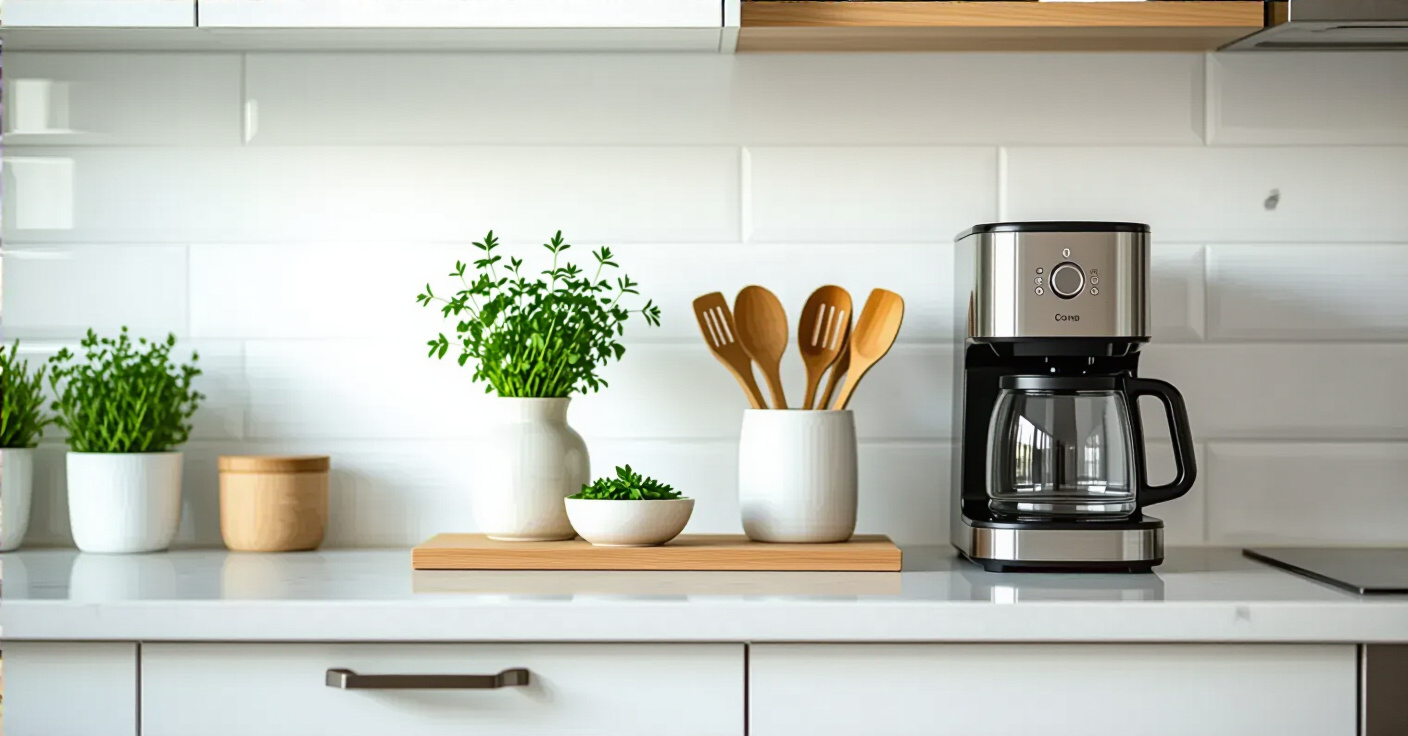
Transform your kitchen into a sanctuary of calm. Discover 21 mindful organization tips that focus on creating peace and flow, not just decluttering your space.
You know what people always ask me? They ask how to organize their kitchen, but what they’re really asking is, “How do I make this chaos in my home feel less like the chaos in my head?” They think the answer is a perfectly labeled pantry and a set of matching bins. And while those things can be beautiful, they are just noise if you don’t get the real part right.
What actually matters is creating a space that breathes. A space that supports you, nourishes you, and doesn’t demand your energy the moment you walk in. Everyone on the internet is selling you a fantasy of a hyper-organized, flawless kitchen. That’s BS. That’s just another thing to feel bad about. The truth is, a mindful kitchen isn’t about perfection; it’s about peace. I once had a client who spent thousands on a custom pantry system, but her stress levels were still through the roof because she never dealt with the root cause—the constant inflow of stuff and the lack of connection to her space. The real shortcut is to stop thinking about “organizing” and start thinking about creating a supportive flow. It’s about gentle edits, not a brutalist purge.
Before we even think about a single new container, we have to start with intention. This isn’t about throwing things away; it’s about consciously choosing what to keep. We’re aiming to create a foundation of calm, a clear canvas upon which we can design a kitchen that truly works for your energy and your life, not just for your stuff.
Let’s reframe this from a “purge” to a “reset.” Think of it as a brief, loving sweep to bring your space back to neutral. For just 15 minutes each day, you simply move through your kitchen and gently put things back where they belong. Mail goes into its tray, the rogue coffee mug goes into the sink, the keys go on their hook. This isn’t about deep cleaning or making a huge effort. It’s the opposite. It’s a small, consistent practice.
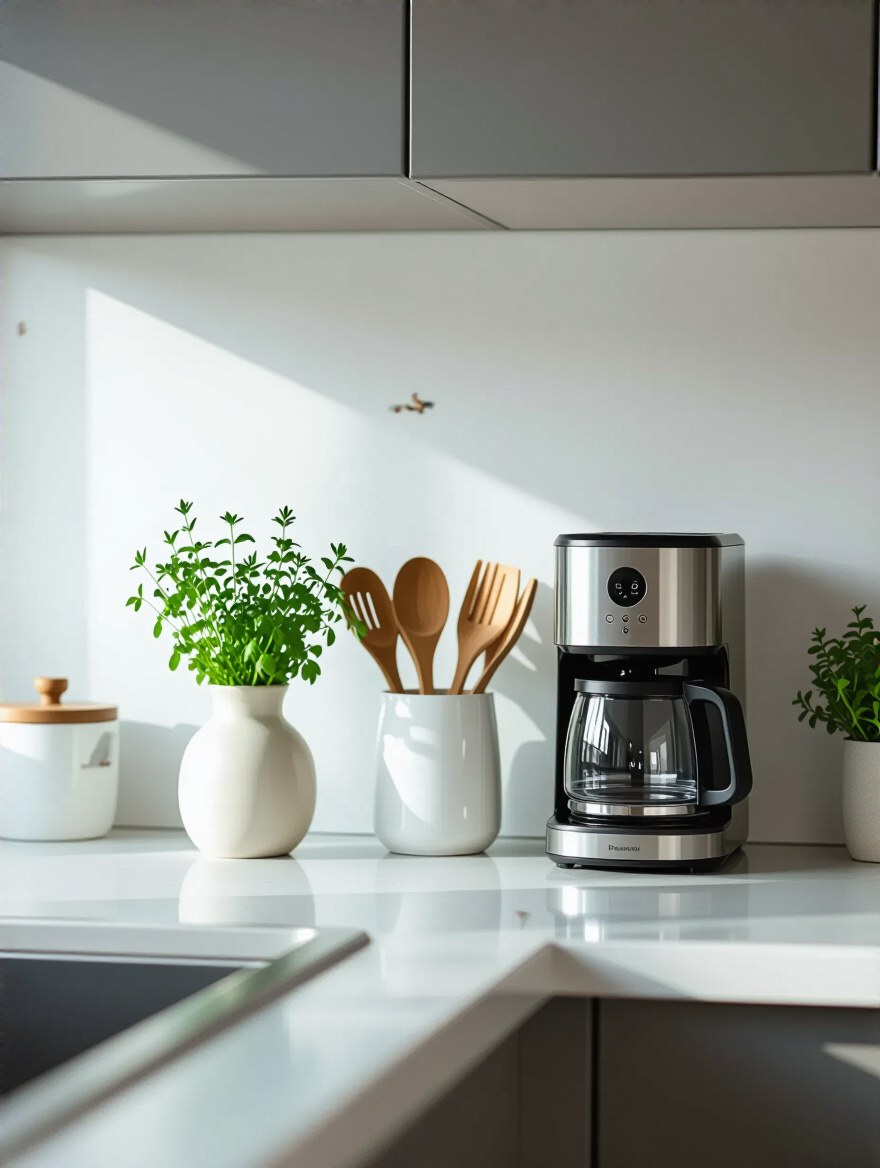
Like a single deep breath in the middle of a hectic day, this tiny ritual prevents the buildup of visual noise. That clutter you see isn’t just physical mess; researchers have found it’s linked to cortisol, our stress hormone. By clearing the surfaces, you’re literally clearing a little space in your mind. It’s a profound act of self-care that tells your nervous system, “This space is calm. You can be calm here.”
With the surfaces clear, your kitchen can finally breathe, giving you the clarity needed to look deeper into the spaces that hold the real clutter—your cabinets and drawers.
This step is where the true mindfulness practice begins. Don’t just shuffle things around. Choose one cabinet—just one—and take everything out. Place every single item on the counter. This is so important, because when things are hidden away, we can’t make honest decisions about them. Bringing them into the light lets you see what you truly have.
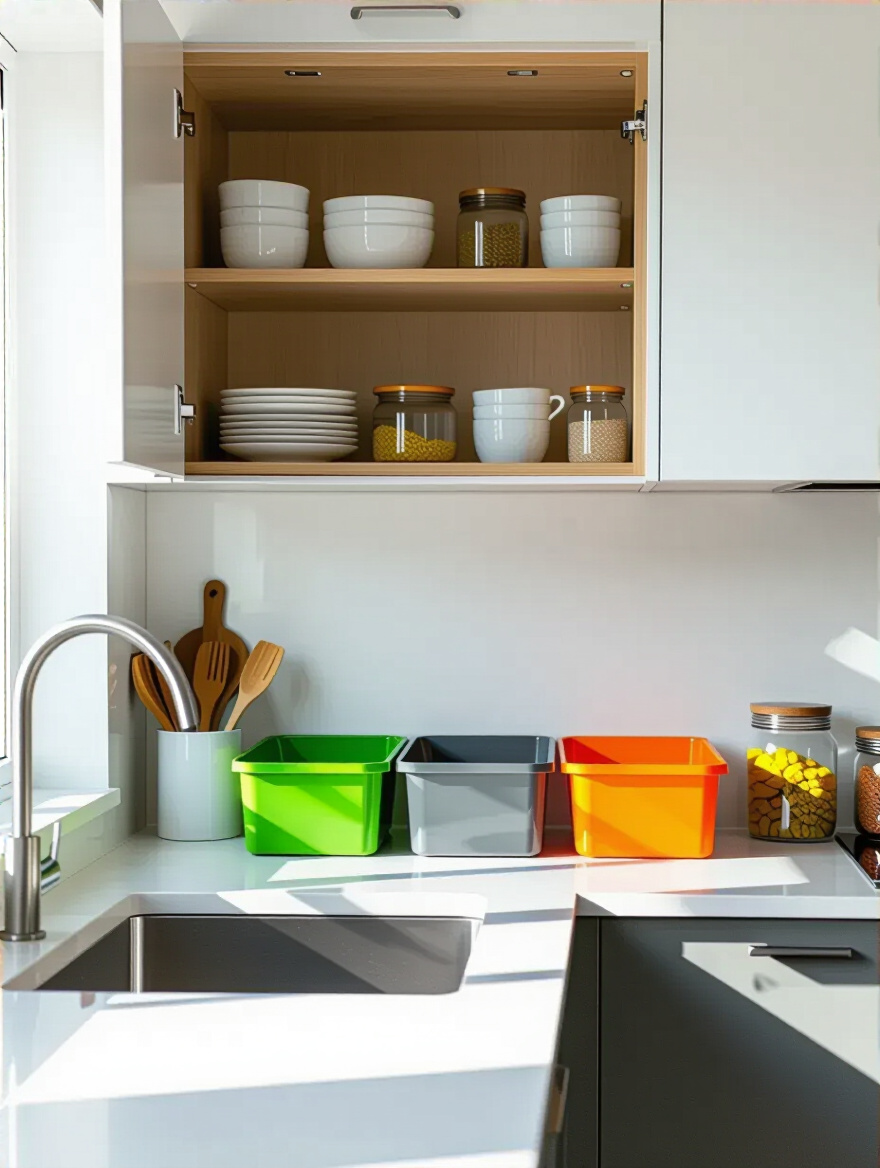
As you pick up each item, ask yourself a simple question: “Does this object support the feeling I want in my kitchen?” Forget asking if it sparks joy for a moment; does that third vegetable peeler bring a sense of ease, or does it add to the clatter? This is how you reclaim your space. I’ve seen clients discover they own seven can openers, most of them broken. By letting go of the six that don’t serve them, they created not just physical space, but a little pocket of mental freedom.
Once you’ve honored each item with your attention, you’re left with only the things that truly belong, ready to be placed thoughtfully into zones that make sense for your spirit and your workflow.
Now we create flow. Think of your kitchen not as a collection of storage units, but as a path your energy travels. Zoning is about making that path smooth and intuitive. The cooking zone, near your stove, should hold the tools you reach for in the heat of creation—spatulas, oils, your favorite pan. It’s about having what you need, right where your hand naturally lands.
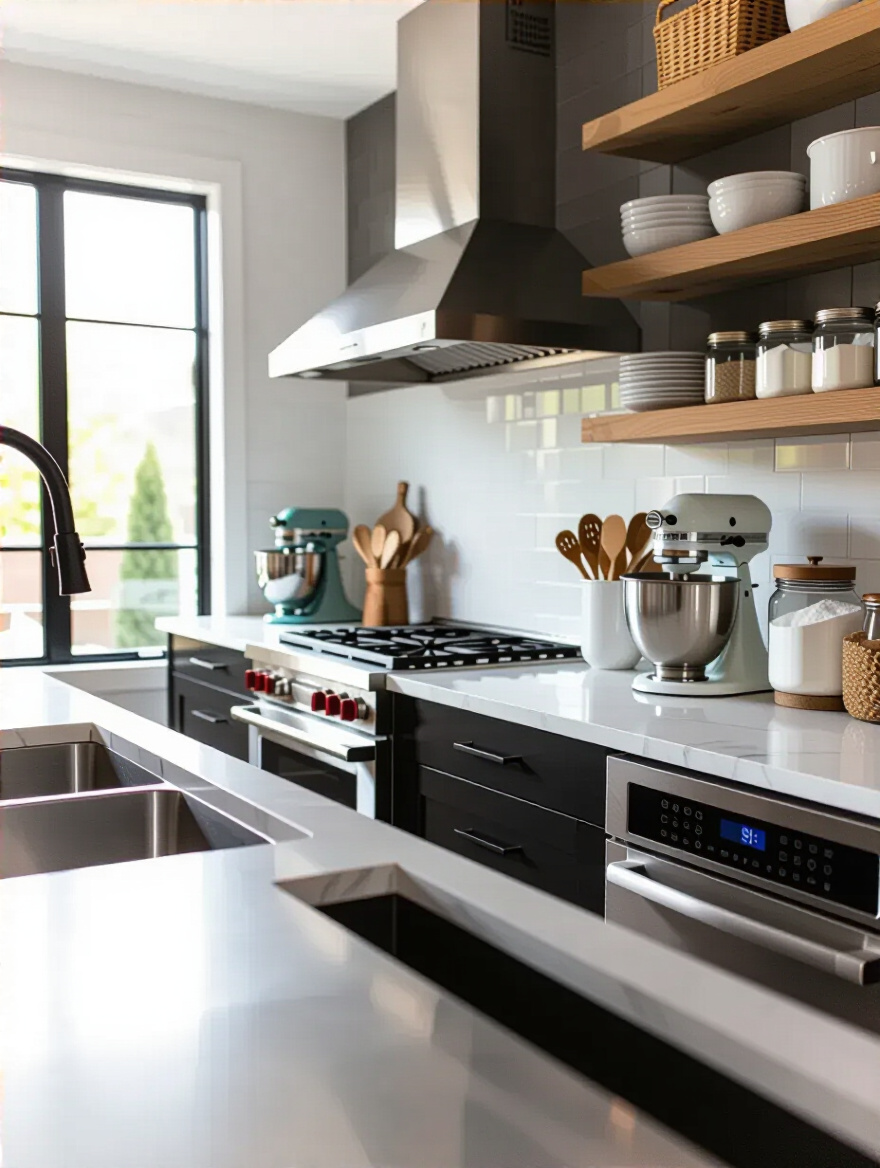
The same goes for other activities. Create a little haven for baking, with your flour, sugar, and mixing bowls all living together. Designate the area around your sink as the cleansing zone, with soaps and sponges neatly contained. When everything you need for a task is gathered in one place, the task itself becomes less of a chore and more of a seamless, meditative ritual. You stop scrambling and start flowing, preserving your precious energy for the creative act of cooking itself.
With the kitchen now mapped for intuitive flow, let’s bring that same calm attention to the heart of your nourishment—the pantry.
Please, don’t do this because you saw it online. Do it because it quiets the noise. A pantry full of mismatched, half-open bags and brightly colored boxes is visually shouting at you. It’s chaotic energy. Decanting—the simple act of pouring your grains, flours, and nuts into clear, uniform containers—instantly brings a sense of visual peace.
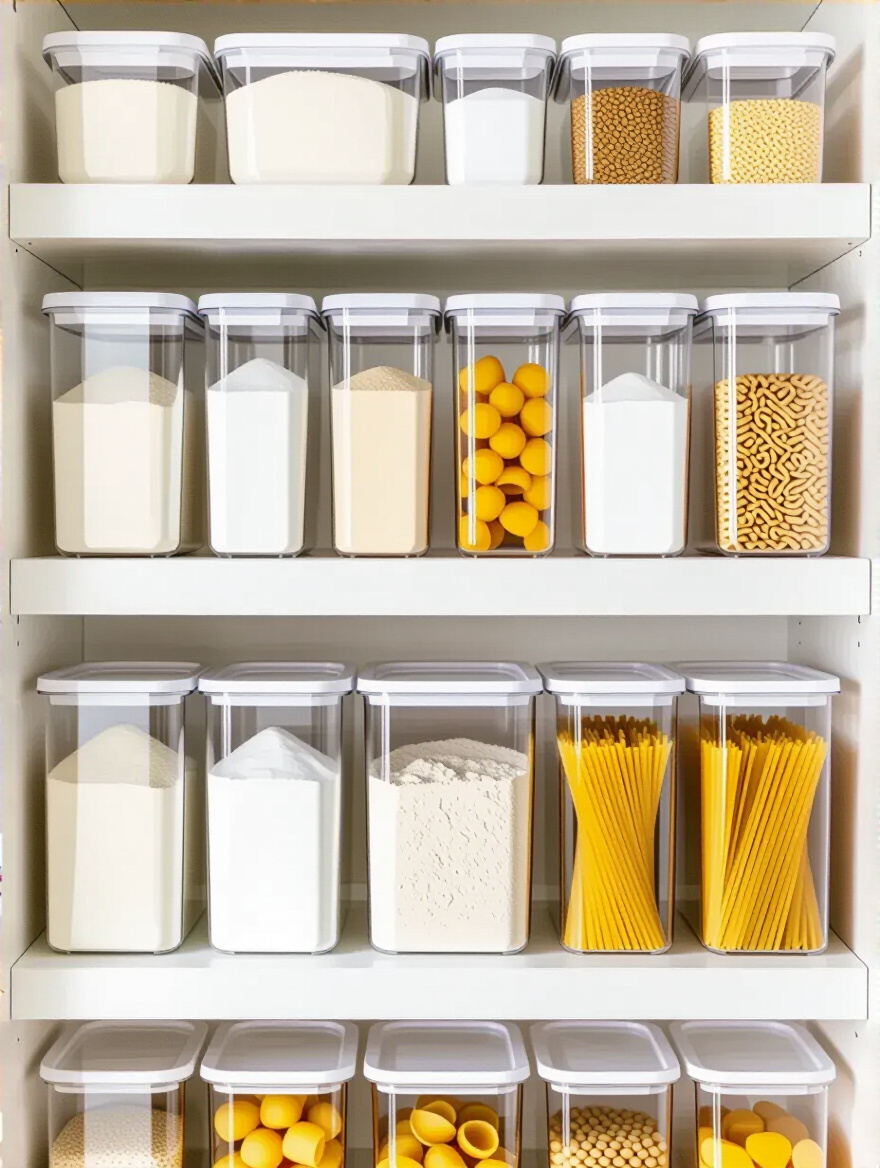
When you can see your food clearly, you connect with it. You see the beautiful texture of the lentils, you know exactly how much flour you have left. This simple act of awareness stops you from overbuying and reduces food waste. It’s a practice of honoring the abundance you already have. More than anything, opening a cabinet to see neat rows of glass jars sends a subtle message of calm and order to your brain, making the very act of gathering ingredients a serene experience.
Now that your food is stored with intention, we can address the appliances that often take over our sacred prep spaces.
Your countertops are sacred ground. This is where you create, where you nourish yourself and your family. And yet, for so many of us, it’s just a parking lot for appliances we barely use—the bread maker from last Christmas, the juicer we had good intentions for. Giving these items a home somewhere else isn’t about banishing them; it’s about honoring your daily needs.
Ask yourself, “What do I use every single day?” The coffee maker, perhaps the toaster. Those can stay, but give them a designated spot. Everything else that is used weekly or monthly can find a home in a deep cabinet or the top of the pantry. I worked with a client who moved her stand mixer and instantly felt like she’d doubled her kitchen size. The clarity was immediate. Reclaiming your countertops is one of the most powerful ways to reclaim a sense of spaciousness and peace in your kitchen.
With your counters now clear and calm, we can bring that same sense of spaciousness to the hidden world inside your cabinets.
The journey inward continues. A calm exterior is lovely, but true, lasting peace in the kitchen comes from knowing that behind every door and drawer, there is order and ease. This is about making these hidden spaces work for you, transforming them from frustrating abysses into intuitive, accessible havens for your tools.
Deep, dark cabinets are where good intentions go to die. We forget what’s in the back, we buy duplicates, and food expires. It’s a cycle of waste and frustration. Pull-out shelves are a beautiful solution because they bring everything out into the light. With one gentle pull, the back of the shelf comes to you. There’s no more kneeling on the floor, no more blindly rummaging.
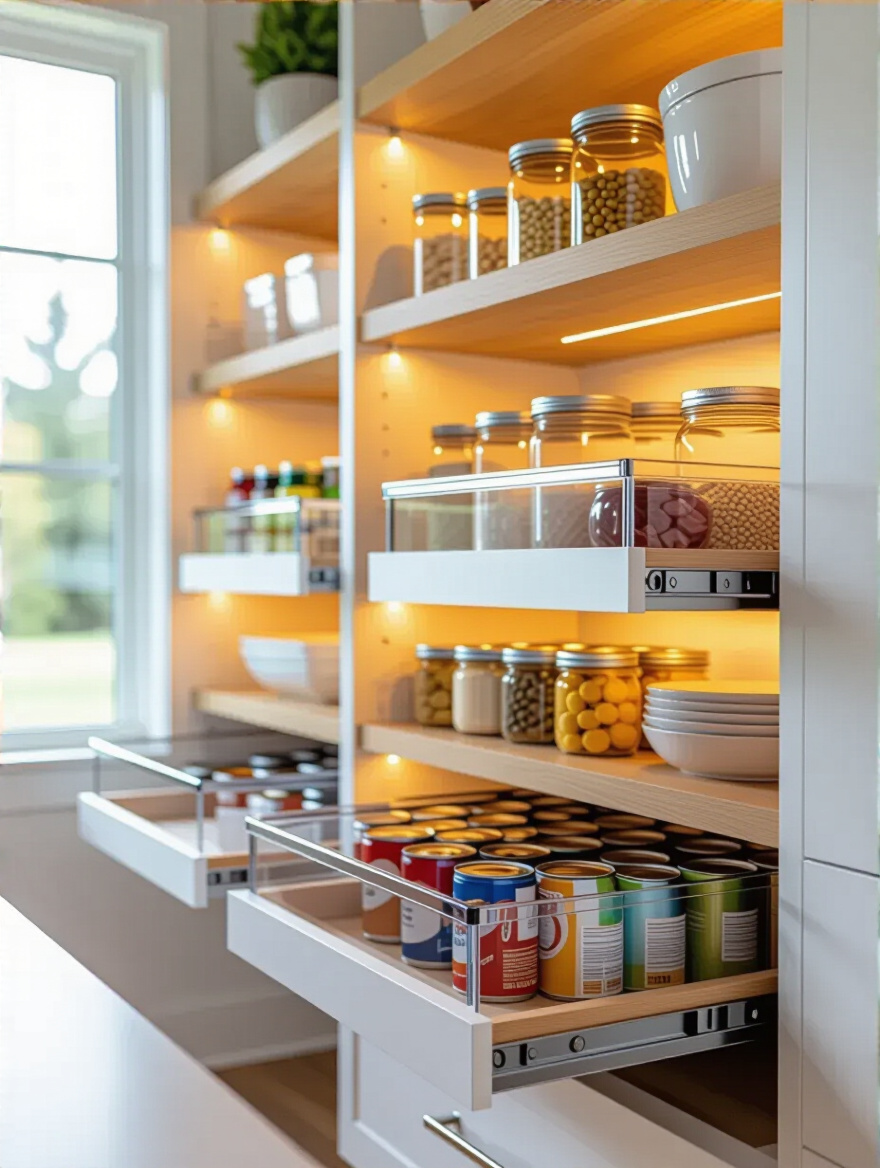
This isn’t just about convenience; it’s about awareness. When you can see everything you own at a glance, you can use what you have with intention. It fosters a sense of gratitude for your resources and dramatically reduces the quiet stress of the unknown. Installing these is an act of kindness to your future self, saving your back, your knees, and your peace of mind every single day.
With the depths of your pantry now accessible, let’s bring that same gentle order to the often-noisy clutter of your cookware.
The sound of crashing pots and pans is the very definition of disruptive energy. Stacking them is a recipe for chaos and scratches. Storing them vertically, however, changes everything. Imagine reaching for a single pan without having to unstack three others. Imagine finding the correct lid in an instant. This is the quiet efficiency that vertical storage provides.
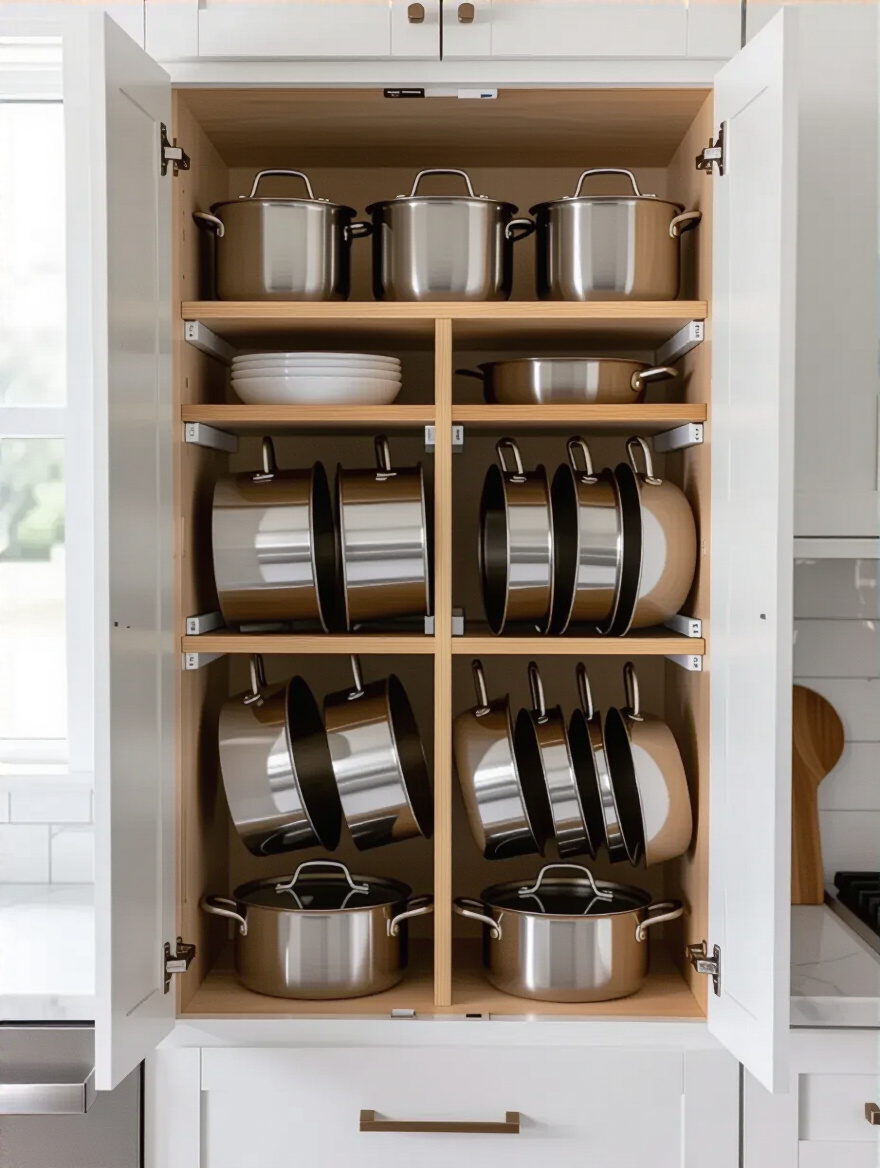
Simple, inexpensive racks can be used to file your pans and lids like books on a shelf. Each one has its own space, ready to be retrieved without a fuss. It’s a small change that removes a major source of daily friction. Cooking becomes calmer when you’re not fighting with your tools before you even begin. The clatter is gone, replaced by a sense of ease.
That same sense of calm, individualized storage can now be applied to the beautiful chaos of your utensil drawers.
The utensil drawer is often a metaphor for a busy mind—everything tangled together, a jumble of competing needs. Adjustable dividers are the answer. They allow you to create a unique and perfect home for everything, a little cradle for your whisks, a specific channel for your spatulas. Suddenly, there is no more tangled mess.
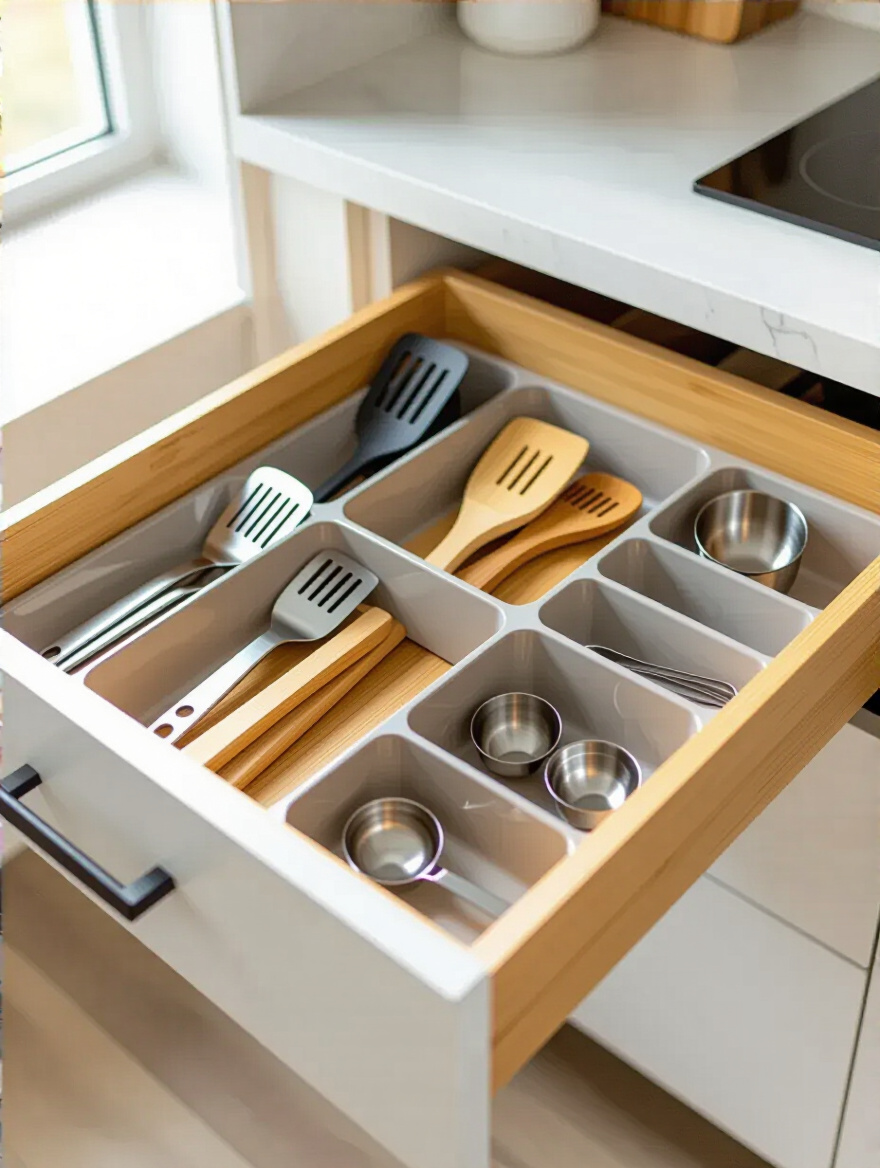
This is another mindfulness practice disguised as an organizing hack. By creating these little zones, you’re bringing order to the chaos. Opening that drawer no longer brings a jolt of stress; it brings a quiet sigh of relief. Everything is visible, accessible, and in its place. The ten seconds you save not looking for the peeler is ten seconds of peace you’ve given back to yourself.
As we bring peace to our tool drawers, let’s not forget the often-neglected and challenging space hiding just beneath the sink.
The space under the sink is often a dark, damp, forgotten corner. But it’s also where we keep the tools for cleansing and renewal. It deserves our mindful attention just as much as the pantry. Tiered shelving, especially designs that fit around plumbing, transforms this awkward space into a highly functional and intentional area.
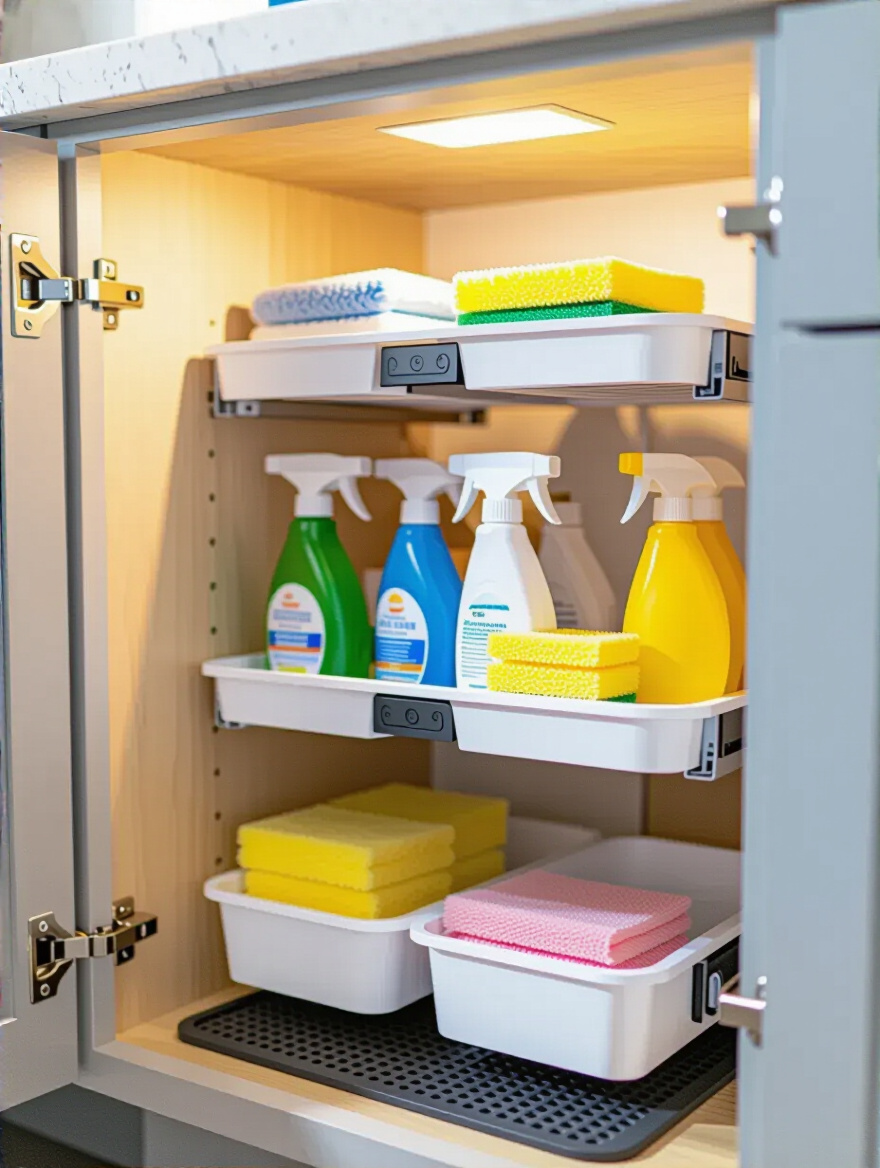
By giving every bottle, sponge, and cloth its own place, you elevate the act of cleaning. It’s no longer a messy task preceded by a frustrating search for supplies. You open the cabinet, you see what you need, and you can proceed with your task calmly. It also creates a safer environment, ensuring chemicals are stored properly. Bringing light and order to even the darkest corners of our kitchen is a powerful way to cultivate a holistic sense of peace.
From one challenging corner to another, let’s now turn our attention to the perplexing geometry of the corner cabinet.
Corner cabinets feel vast, but their depth and awkward angles often make them unusable black holes. A Lazy Susan is a beautiful tool of transformation. With a simple, gentle spin, it brings everything that was hidden in the darkness forward into the light. Nothing is lost, nothing is forgotten.
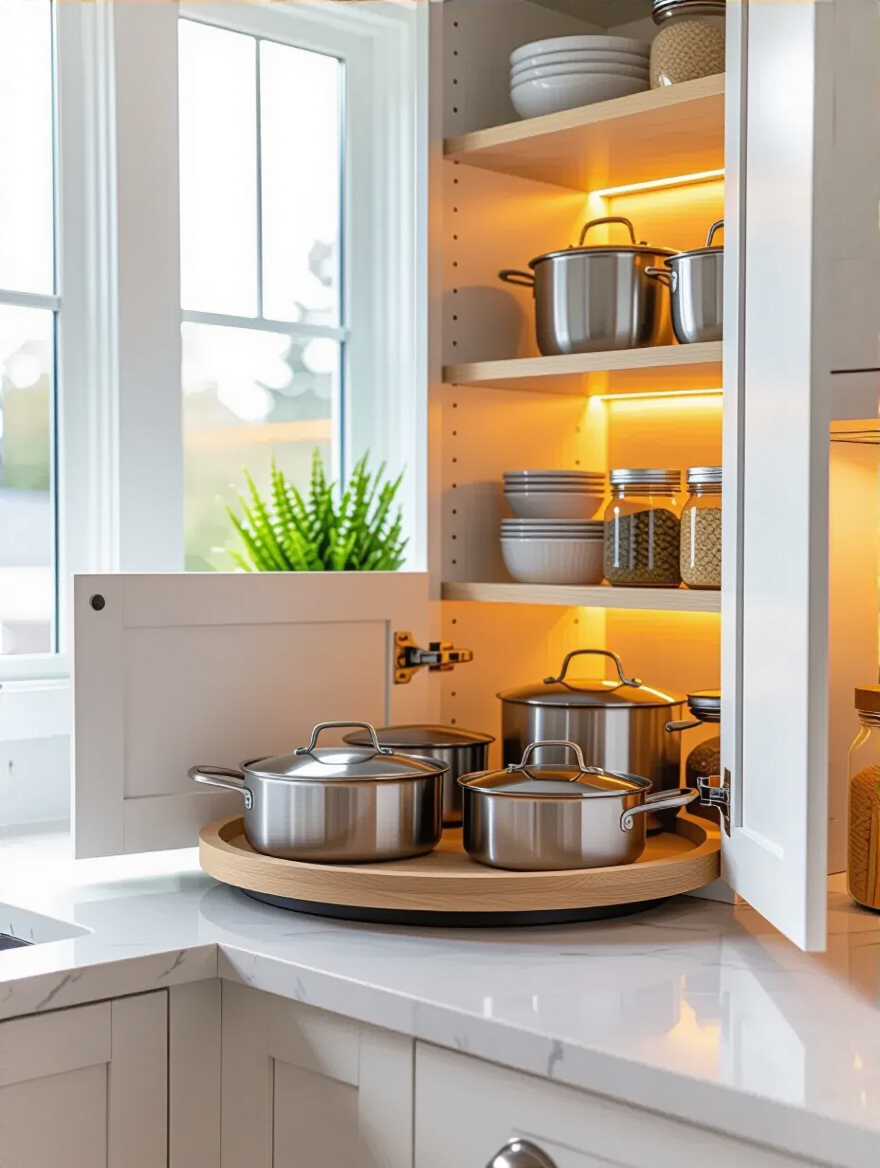
This is the principle of accessibility creating mindfulness. When you can easily see and reach everything you own, you are more likely to use it and appreciate it. It allows you to store larger items like pots, pans, or small appliances with an ease that feels almost magical. The gentle rotation is a quiet, satisfying motion that replaces the strain of digging into a deep, dark corner. It’s another way of designing flow and ease directly into the structure of your space.
Now that we’ve made even the most awkward spaces functional, let’s look at how the design of our tools themselves can create a sense of harmony.
There is a deep, satisfying peace that comes from things that fit perfectly together. Nesting bowls and containers are a beautiful example of this. Instead of a teetering, chaotic pile of plastic and glass, you have a single, tidy stack. Each piece has its place within the whole, creating a sense of completion and order.
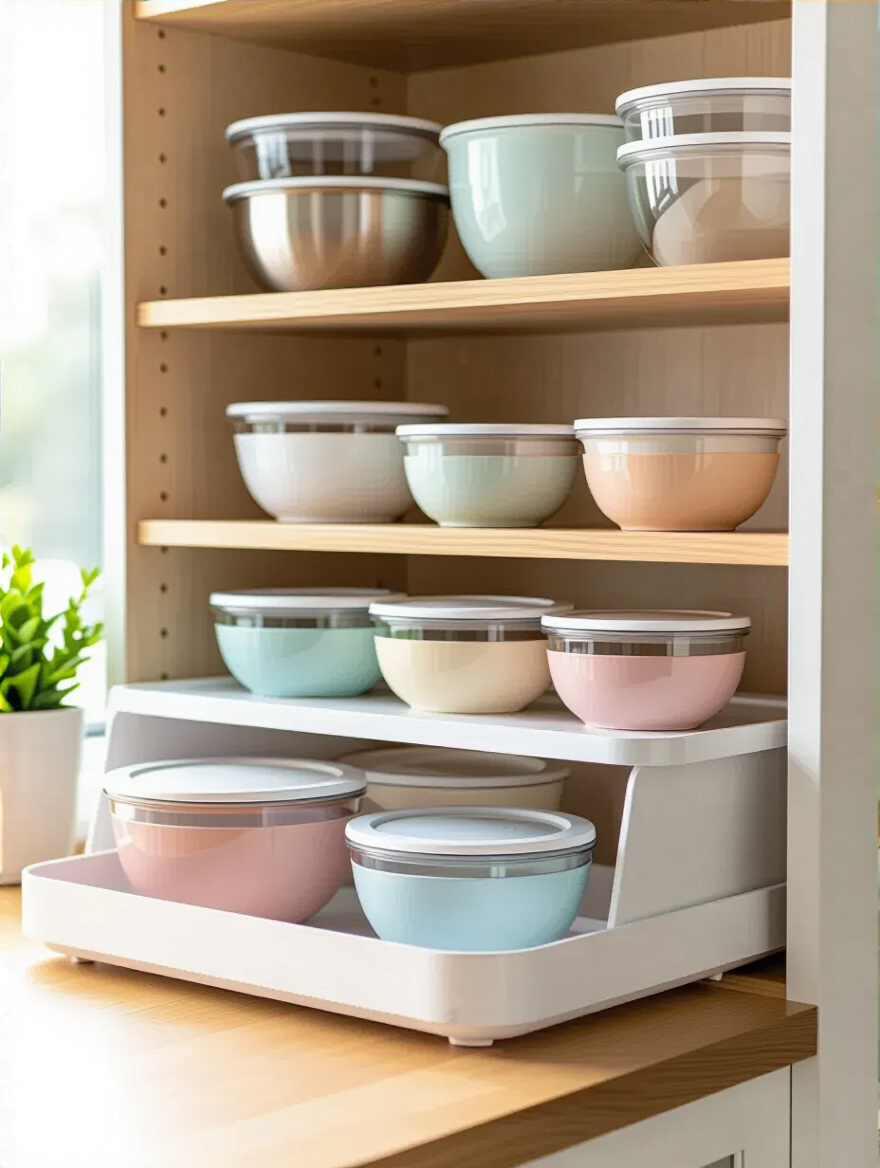
This is about more than just saving space, although it does that beautifully. It’s about the visual calm that comes from reducing many things into one. When you open your cabinet and see a single, contained stack, your mind registers order. And when it comes time to find the right lid for the right container, the frustration is gone, because they are designed to live together in harmony. Investing in a set like this is an investment in daily moments of effortless calm.
Having brought harmony to the interior of our cabinets, we can now look beyond them to the untapped potential of our kitchen’s open spaces.
A truly mindful kitchen understands that every surface holds potential. This isn’t about filling every space, but about using overlooked areas with intention and grace. We’ll explore how vertical surfaces and thoughtful stations can add function and peace, turning blank walls and forgotten doors into quiet servants of your daily rhythm.
A bulky knife block can feel like a heavy, dense object on your countertop. It takes up visual and physical space. Lifting your knives onto a magnetic strip is an act of liberation. It frees your counter, turning your beautiful tools into a piece of functional art. They are displayed, accessible, and ready for you, bringing a touch of the professional chef’s kitchen into your home.
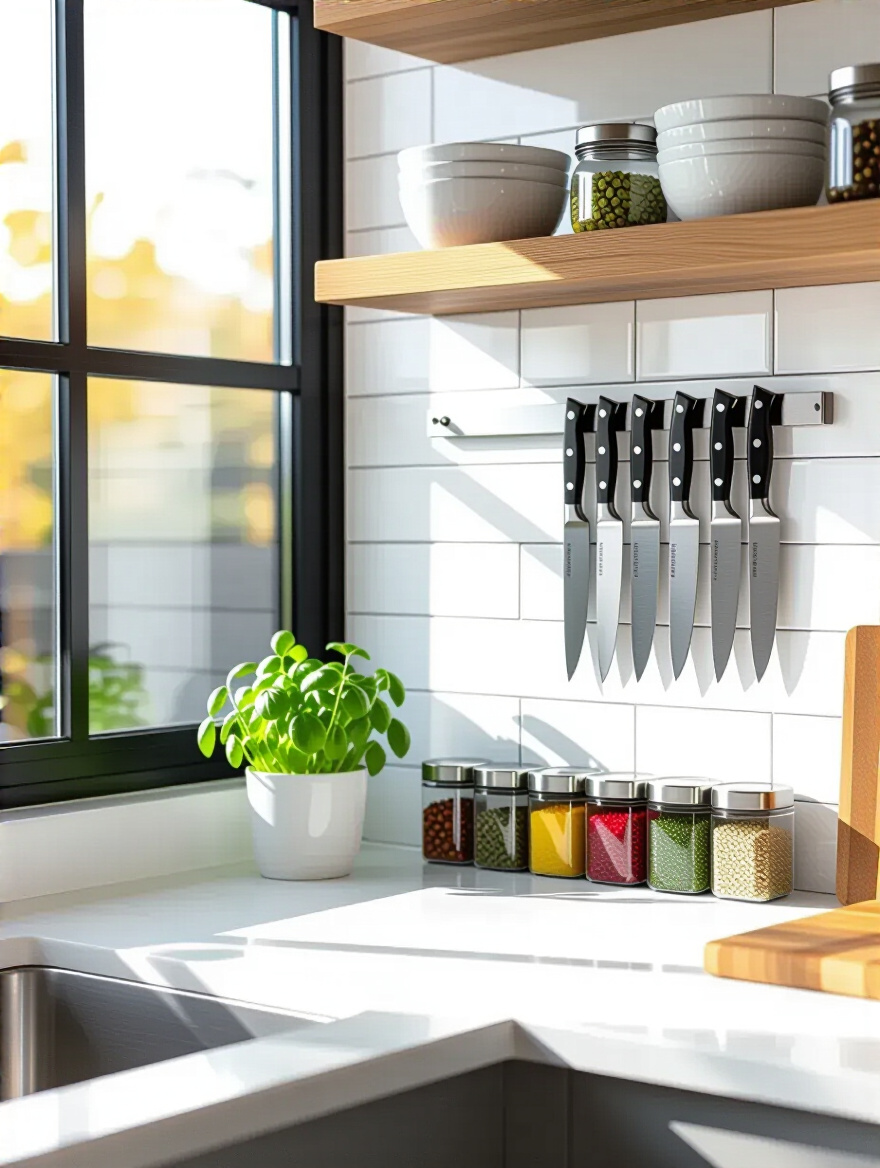
The same principle applies to spices. Lifting them out of a crowded cabinet and into the light—either on a magnetic strip with metal tins or a small wall-mounted shelf—turns them into a palette of flavors and colors. You can see everything at a glance, making you more likely to be creative and use the beautiful spices you already own. This practice turns a blank wall into a source of inspiration and ease.
With our most essential tools now beautifully at hand, let’s consider creating a space of empowerment for the smallest members of our household.
For parents, the constant refrain of “I’m hungry” can be a source of endless interruption, fracturing focus and calm. Creating a dedicated snack station for children is an act of peace—for them and for you. Designate a low drawer or a basket on a bottom shelf and fill it with healthy, pre-approved options they can access themselves.
This simple system fosters a beautiful sense of independence and self-sufficiency in a child. It also gives you back your own mental space. Instead of being an obstacle, the kitchen becomes a place where they, too, can feel capable and empowered. The visual order of the station, with everything in its place, teaches them the principles of a calm space from a young age.
Just as we created a dedicated home for snacks, let’s use a similar principle to give a home to another small set of tools that often gets lost in the shuffle.
The gentle jingle of measuring cups is a sound of happy creation, but not when you’re rummaging through a drawer to find them. The inside of a cabinet door is a secret space just waiting to be of service. Placing a few small, simple hooks there creates the perfect home for your measuring cups and spoons.
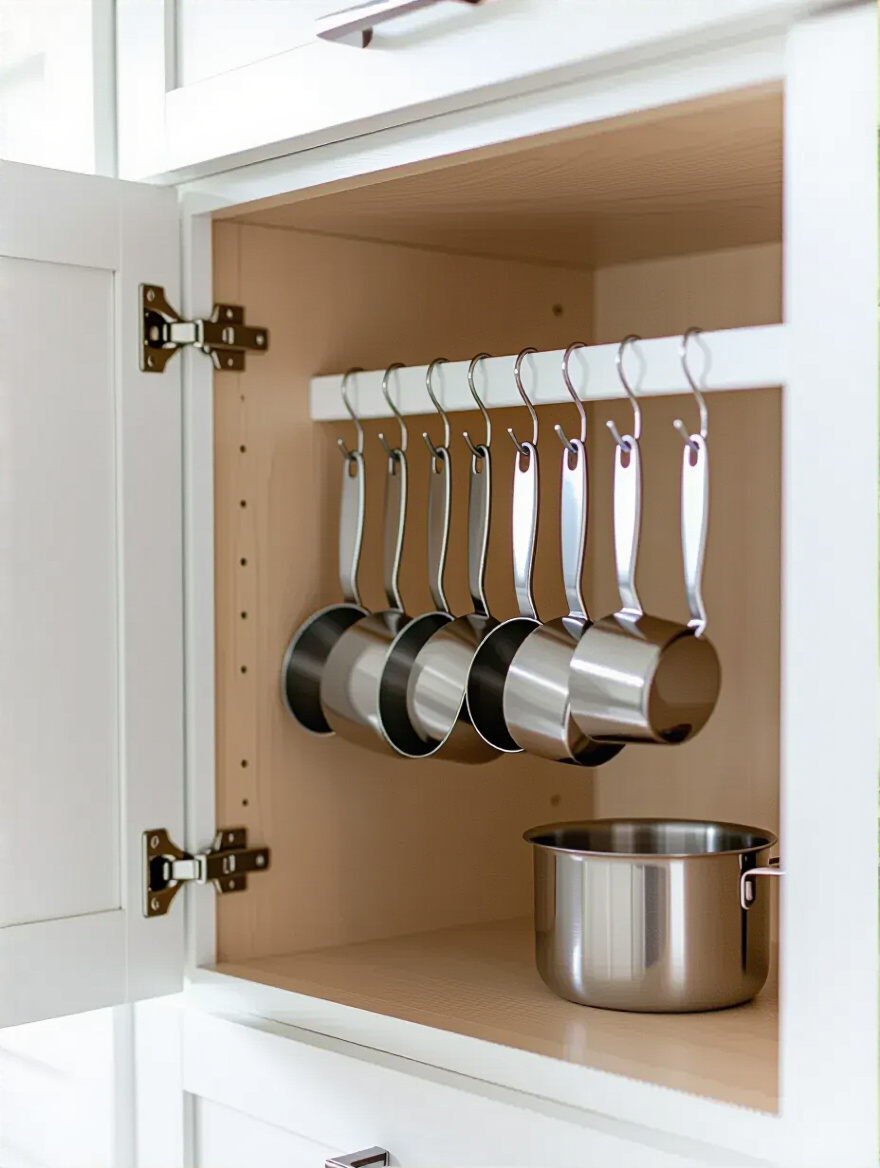
By hanging them in order, you transform a jumbled mess into a tidy, accessible display. This is a perfect example of how a tiny, mindful change can remove a daily point of friction. Every time you bake, you’ll open that door and feel a small moment of satisfaction and ease instead of frustration. It’s these tiny moments, compounded over time, that create a truly serene kitchen experience.
Moving from the small space inside a door to the larger canvas of a wall, we can expand this principle of vertical display even further.
A pegboard is like a blank canvas for your kitchen tools. It takes everything out of crowded drawers and deep cabinets and lifts it into the light. It’s an incredibly honest and functional way to store things, allowing you to see everything you have at a glance and to create a custom layout that perfectly matches your workflow.
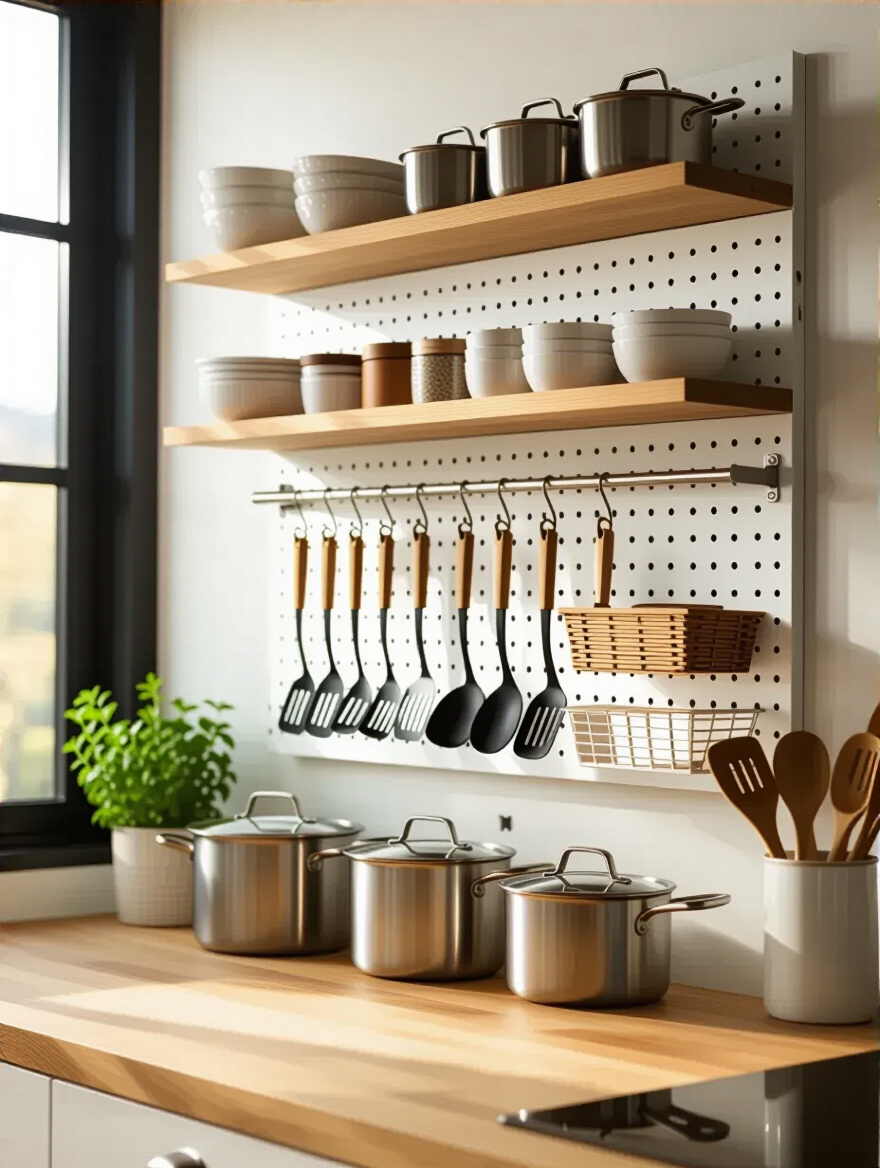
There is a sense of professional calm to a well-organized pegboard. It’s dynamic; as your needs change, you can simply move the hooks. It’s perfect for hanging pots, pans, whisks, and spatulas, keeping them within arm’s reach of your prep area. This open storage concept encourages you to only keep the tools you truly love and use, as they become a part of your kitchen’s decor.
As we continue to explore the hidden potential of our kitchen, let’s turn our attention to another humble door with a secret storage identity.
The back of a door is one of the most underutilized spaces in a home. In a small pantry, an over-the-door organizer can be utterly transformative. The clear pockets are perfect for holding all the small, easy-to-lose items: spice packets, snack bars, tea bags, and kid’s juice pouches.
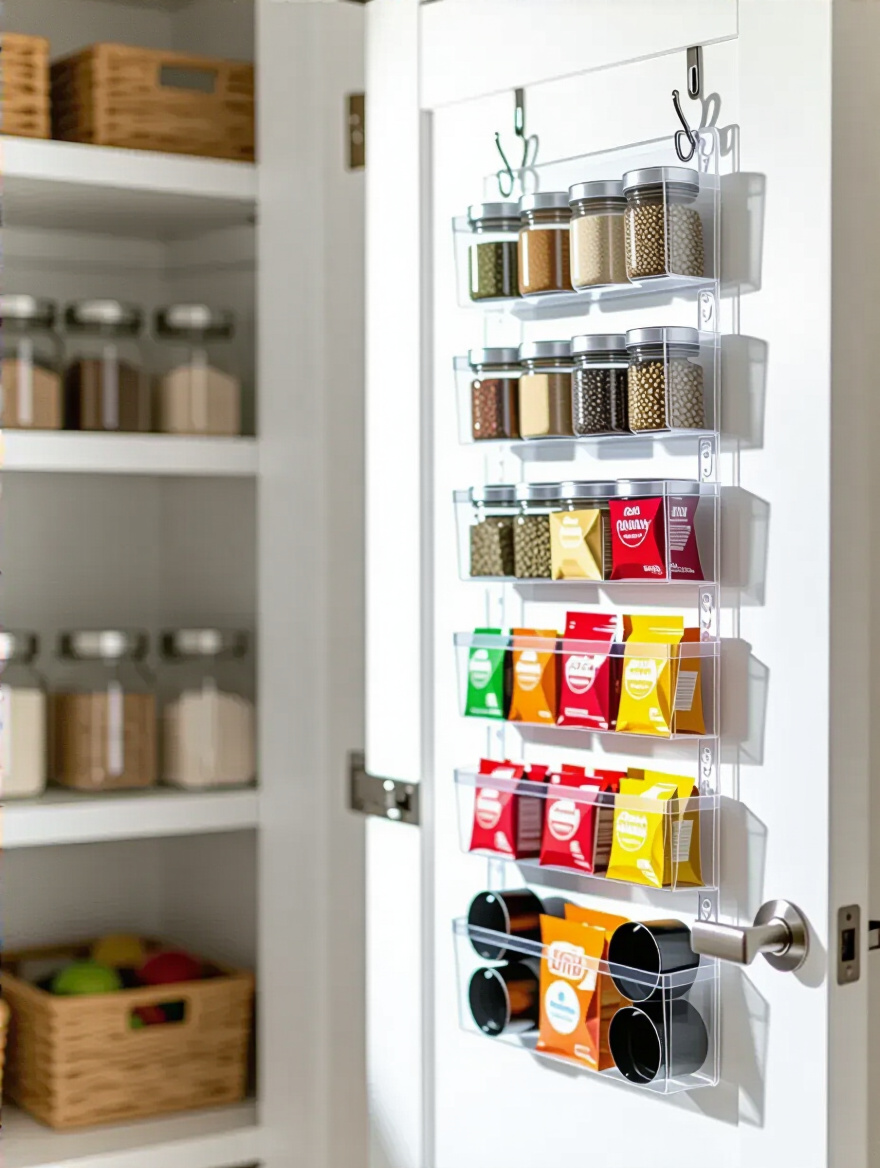
This is another practice that brings everything into the light. No more half-empty boxes cluttering your shelves or small packets getting lost in the back. Everything is visible and easy to grab. This not only saves you time but also money, as you’re no longer buying duplicates of things you already have but couldn’t see. It’s a simple, inexpensive way to add a huge amount of calm, accessible storage.
These innovative solutions bring a deep sense of order to our physical space. Now, let’s turn to the final, most crucial phase: cultivating the habits that will sustain this peace long-term.
Creating a peaceful kitchen is a beautiful act of intention. Sustaining it is a daily practice. This final phase is about embedding gentle habits and mindful check-ins into the rhythm of your life, ensuring the calm you’ve cultivated becomes your new, effortless normal. It’s not about rigidity; it’s about nurturing the beautiful space you’ve designed.
Think of this not as cleaning, but as closing the circle. After you have finished the beautiful act of cooking, take just sixty seconds to bring the space back to a state of readiness. Wipe the counter where you chopped, return the oil to its shelf, and place the used bowl in the sink. This is not about scrubbing the kitchen from top to bottom. It’s a tiny gesture of respect for your space and for your future self.

By integrating this micro-habit, you prevent the buildup of mess that feels so overwhelming later. It becomes a seamless part of the cooking process, like turning off the stove. When you sit down to eat, you can do so in a space that is already calm and peaceful, allowing you to be fully present with your meal instead of staring at a mountain of cleanup ahead.
While this brief ritual maintains daily peace, our systems of organization need a slightly deeper, more intentional check-in from time to time.
Our lives are not static, and our kitchens shouldn’t be either. A quarterly reassessment is a loving check-in with your space. It’s a chance to spend a couple of hours revisiting the zones you’ve created and asking, “Is this still serving me?” You might notice your baking habits have changed, or that a certain tool would be better stored elsewhere.
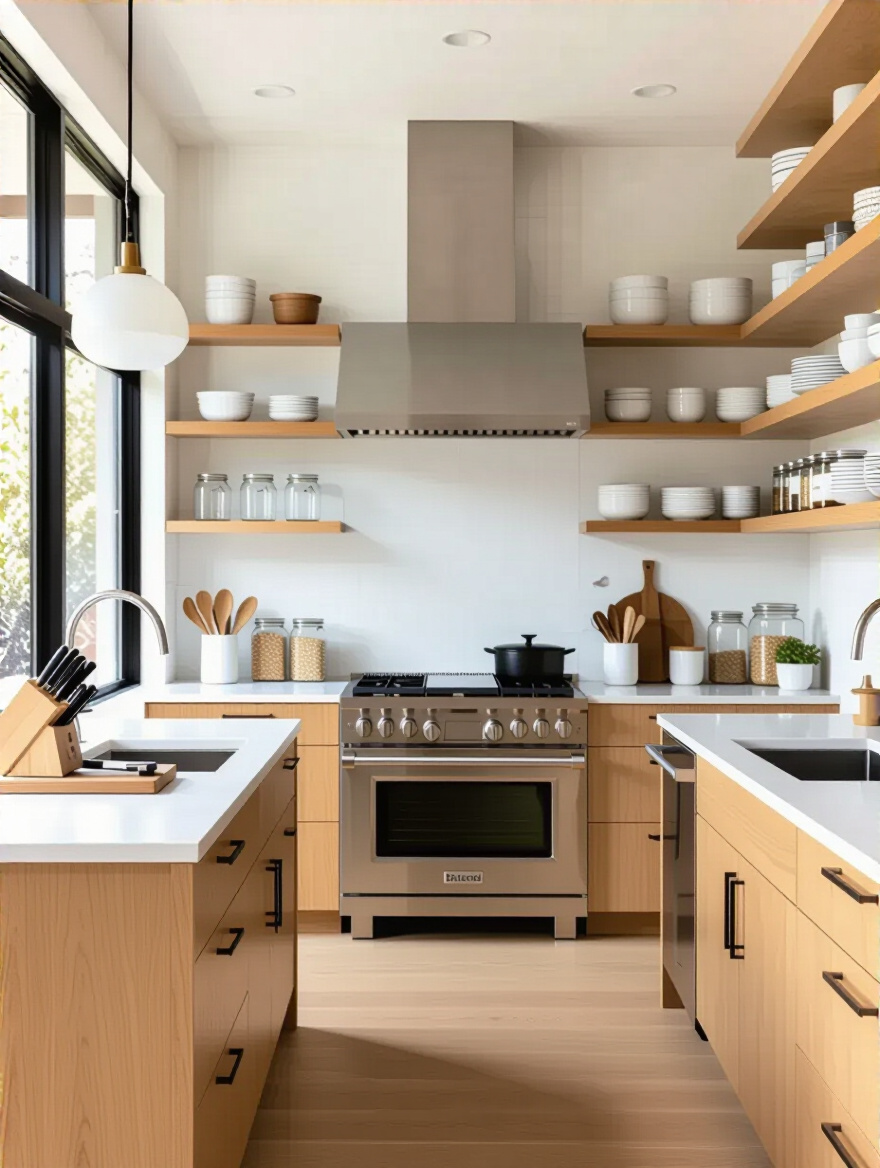
This isn’t a chore; it’s an act of tuning your environment to be in perfect harmony with your current life. It’s when you wipe down the shelves, check expiration dates, and gently prune anything that no longer feels right. Scheduling this on your calendar—once a season—turns it into a predictable, manageable ritual of renewal rather than a dreaded, overwhelming task that only happens when you can’t stand the mess anymore.
This regular check-in ensures your systems remain fluid and supportive. To prevent them from becoming overwhelmed in the first place, we need a simple rule for everything that enters your kitchen.
A peaceful kitchen is not an empty one, but it is an intentional one. The ‘one in, one out’ practice is the gatekeeper of that intention. When you bring home a new mug, you lovingly select an old one to release. When you buy a new, better spatula, the old one goes into the donation box. This isn’t a rule of deprivation; it’s a practice of conscious curation.
This simple commitment completely prevents the slow, creeping accumulation of clutter. It forces you to pause before every purchase and ask, “Do I truly need this? And if so, what is it replacing?” This habit moves you from being a passive consumer to an active, mindful curator of your own space. It ensures your kitchen remains a haven of just what you need—no more, no less.
With this powerful gatekeeper in place, let’s add one final layer of clarity to make using and maintaining your space absolutely effortless.
Labeling isn’t about creating a rigid, hyper-organized system. It’s about removing the need to think. When you open a cabinet and a simple, elegant label says “Grains” or “Baking Spices,” your mind doesn’t have to work to figure things out. It can stay calm and focused. A label is a quiet whisper telling you, “What you’re looking for is right here.”
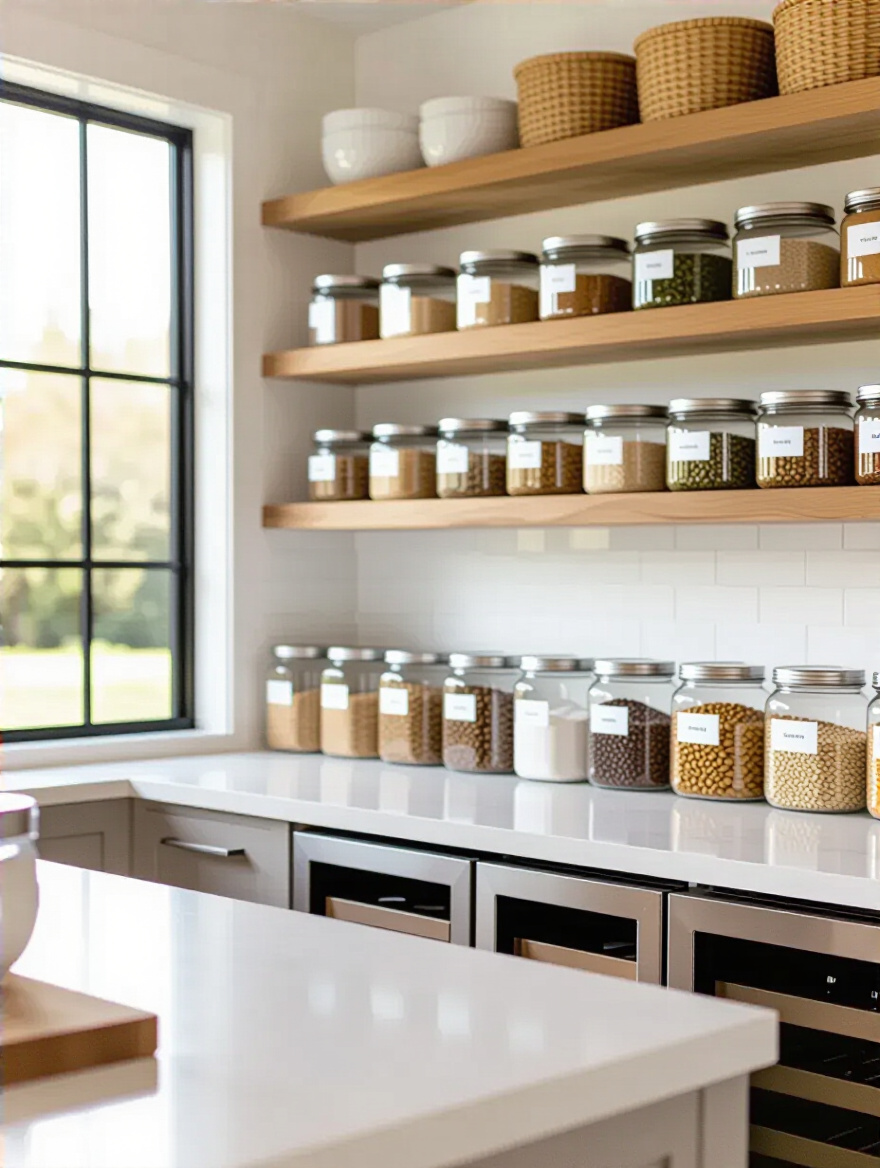
This simple act of naming things brings an incredible amount of ease to your daily routines. Anyone in your family can find what they need and, just as importantly, put it back in the right place. It makes taking inventory for grocery shopping a two-second glance instead of a ten-minute hunt. Clear labels are a gift of mental energy back to yourself, day after day.
And for those items that, despite our best intentions, are ready to leave our home, we need one final, graceful system.
Clutter happens when we don’t have an easy path for things to exit our homes. A dedicated donation box is that graceful exit path. Tucked away in a pantry corner or a nearby closet, it becomes the designated waiting room for items that are ready for their next chapter—the mug that’s no longer your favorite, the gadget you tried but didn’t love.
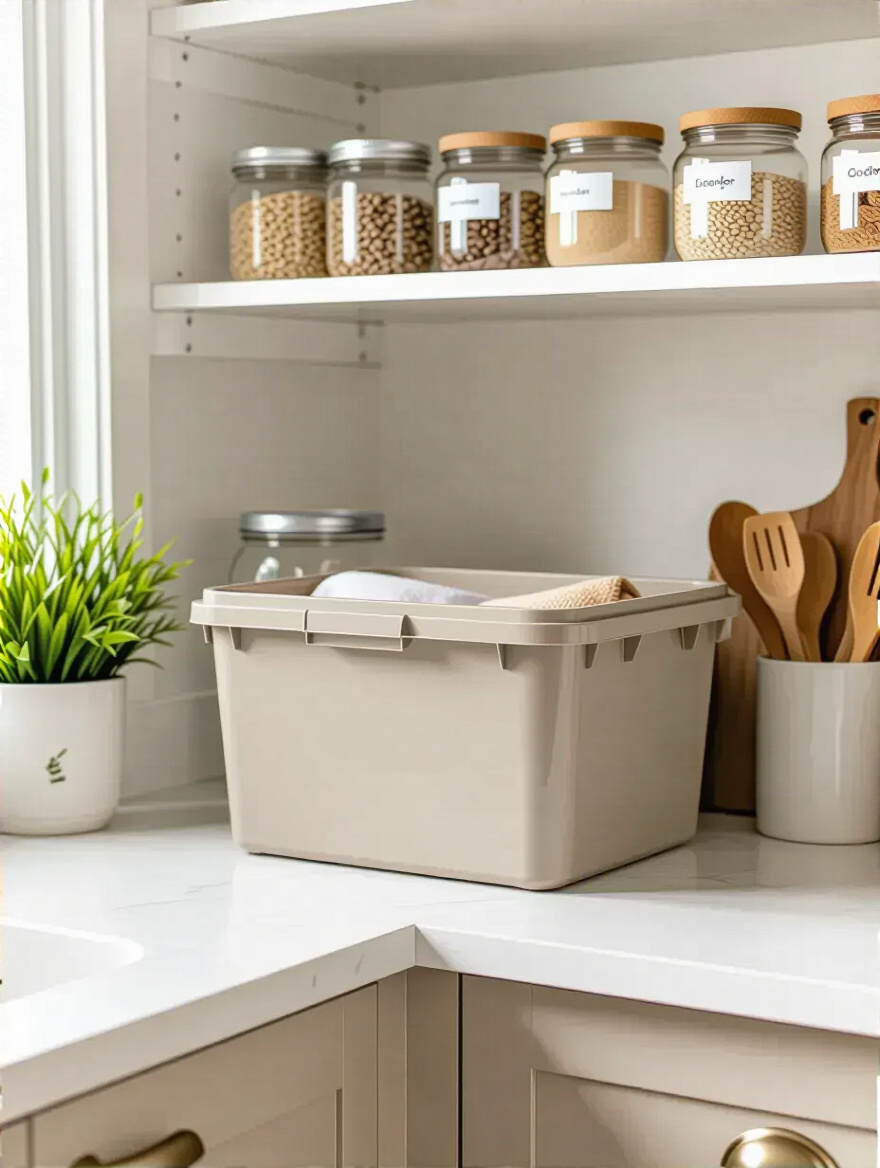
Instead of letting these items linger on your counters or in your cabinets, creating guilt and clutter, you can immediately place them in the box. This makes the decision to let go immediate and painless. Then, once a month or so, you simply take the box to your local donation center. It’s a continuous, gentle cycle of release that keeps energy—and stuff—from stagnating in your home.
Creating a kitchen that feels like a sanctuary isn’t a weekend project; it’s a gentle, ongoing practice. It’s about understanding that the state of our environment is a direct reflection of our inner state, and that by bringing calm and intention to our physical space, we can cultivate more of it within ourselves. The goal was never a perfect, magazine-worthy kitchen, but a kitchen that feels like a deep, supportive exhale.
Don’t feel overwhelmed by this list. The path to a mindful kitchen begins with a single, small step. This week, just choose one thing. Maybe it’s setting a timer for a 15-minute reset each evening. Or perhaps it’s taking everything out of a single drawer and consciously putting back only what serves you. Start small. Be gentle with yourself. The peace you are seeking is not found in a set of new containers, but in the quiet, consistent care you bring to the heart of your home. Your sanctuary awaits.